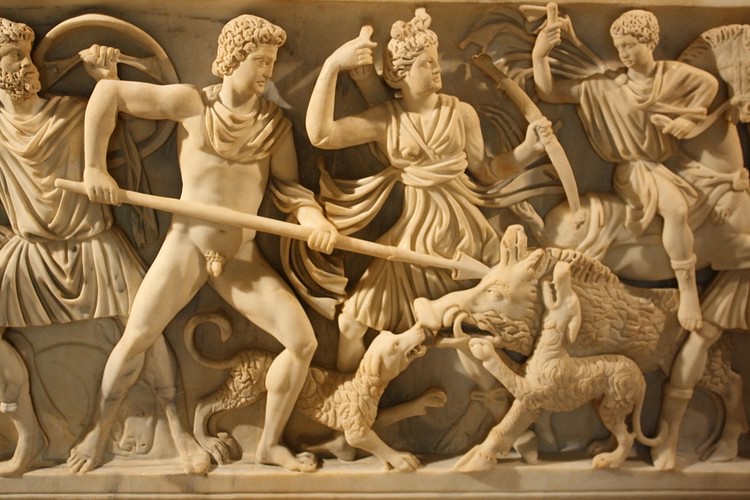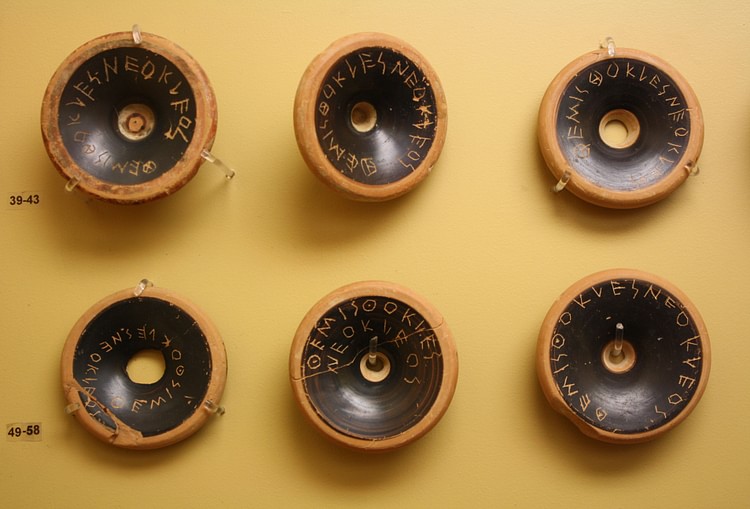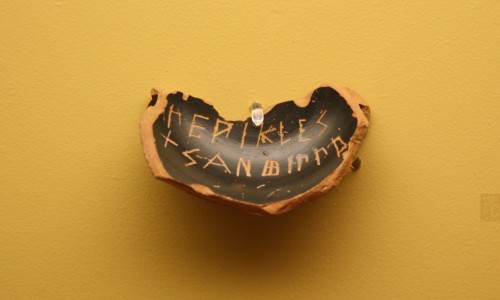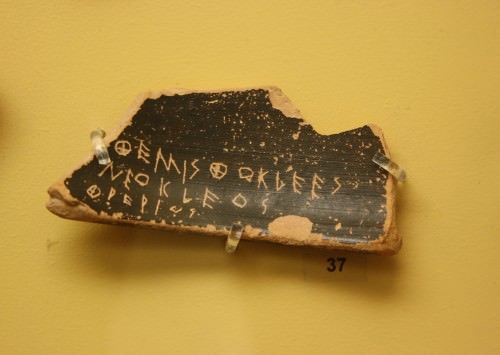Meleager › Ostracism » Ancient origins
Articles and Definitions › Contents
- Meleager › Who Was
- Ostracism › Antique Origins
Ancient civilizations › Historical and archaeological sites
Meleager › Who Was
Definition and Origins

Meleager ( Greek : Meleagros) is a hero from Greek mythology who famously led an expedition to kill the Calydonian boar which was terrorizing the kingdom of Oeneus in Aetolia in central-western Greece. Appearing in Homer ’s Iliad and the later epics the Ehoiai and Minyas, the story was a popular subject in Greek and later art from pottery decoration to sculpted sarcophagi.
THE CALYDONIAN BOAR HUNT
The story of Meleager is first mentioned in Book 9 of Homer's Iliad, although the oral tradition is likely much older. The tale, modified by Homer, is recounted by Phoenix in order to persuade Achilles to rejoin the fighting during the Trojan War.Achilles was miffed that Agamemnon, leader of the Greek army, had stolen his beautiful war -prize Briseis. With things not going well, the desperate Greeks sent an embassy of Odysseus and Phoenix to convince the greatest Greek warrior to rejoin the fray. Accordingly, Meleager and the Calydonian boar hunt is used as a moral tale to show Achilles the right course of action.
Phoenix tells us that the story is from long ago, the time of heroes. The trouble started when Oeneus (or Oineus) the king of the Aetolians in Calydon (Kalydon) in the central-western part of Greece forgot to make a sacrifice to Artemis. Apparently, the king had made sacrifices to all the other gods of Olympus but for some reason left out the goddess of hunting. Upset at this slight, Artemis sent a huge boar with a bristling hide and great white tusks to terrorize the kingdom. First the beast caused havoc with the king's orchards but then also started killing men when they tried to capture it. Eventually, Oeneus set his son Meleager the task of forming a team of heroes capable of subduing the monster.
MELEAGER WAS A GREAT WARRIOR AND HAD ALREADY GAINED RENOWN AS ONE OF THE ARGONAUTS.
Meleager was a great hunter and warrior – indeed, in some versions he is the son of Ares, the god of war – and he had already gained renown as one of the Argonauts who, with their leader Jason, had successfully found the Golden Fleece.Meleager, his all-star heroes team – who included the Dioskouroi, Jason, Theseus, Peleus, and Atalanta in their ranks - and their hounds did kill the boar but, unfortunately, a war broke out over ownership of the head and hide. This war was fought between the Aetolians and local rivals the Curetes (also Kouretes – not to be confused with the Cretan tribe of the same name), the latter besieging the city of Calydon.
MELEAGER & THE CURETES
The war rumbled on and things were not going too badly for the Aetolians as the stout walls of their city resisted everything the Curetes could throw at them. Then, just like Achilles, Meleager got fed up with the fighting and withdrew. He was also angered by his mother, Althaea, who had cursed him for the slaying of his uncle and so, finished with the war, he just wanted to spend more time with his lovely wife, Kleopatra. Without Meleager's fighting skills the Aetolians started to lose the conflict. Embassies were sent to the hero pleading with him to defend his city in its greatest hour of need – his parents, priests, friends, and even his sisters begged him to fight, but this and the promise of great gifts and any part of the kingdom he wished to have failed to move Meleager. Only after Kleopatra pleaded with the hero and reminded him of the terrible fate of a city sacked by its enemies did he finally rejoin the fighting. Donning his shining armour Meleager led the Aetolians to final victory but, as it happened, never received his promised gifts.
Phoenix points out to Achilles that he is making his people suffer unnecessarily just like Meleager and if he joins the fighting again now, then he will not lose out on his promised gifts. In the end, it would be the death of Patroclus, Achilles' great friend, which would persuade him to fight again the Trojans and not this pretty moral tale from Phoenix.

Meleager & the Calydonian Boar
MELEAGER'S DEATH
In the Greek tradition, Meleager dies, of course, but we do not know in what circumstances, even if some sources declare that he was killed by Apollo. In later traditions, Meleager's death is elaborated upon and we are told that the manner of his death was foretold even before his birth. His mother, Althaea, was warned by the three Fates that her son would live for as long as an ember in her fireplace withstood the flames. Althaea then immediately took the ember, extinguished it and kept it safe in a cupboard. Then, much later and after the successful Calydonian hunt, Meleager killed his two uncles in mysterious circumstances – possibly after they had stolen the boar hide from Meleager's love interest, the warrior Atalanta. The famous huntress had been gifted the hide as a reward for her spear being the first to pierce the boar's thick hide. At the news that her brothers had been killed, Althaea took the ember and rashly threw it into the fire and when it expired so too did Meleager. In dreadful remorse Althaea took her own life.
Meleager does make one final appearance in Greek mythology when he meets the hero Hercules in Hades. Hercules was on his final labour to capture the three-headed dog Kerberos who guarded the gates of Hell. The spirit of Meleager whispered to Hercules to carry a message of love to his sister Deianeira in the world of the living and he recommended his sister for the hero's wife.
MELEAGER IN ART
The story of the Calydonian boar hunt first appeared in Greek art in the 6th century BCE on pottery and it remained a popular subject through to Roman times. One of the earliest certain depictions is on the Francois Vase (570-565 BCE) where the characters and even the dogs are named. In sculpture, the myth was represented on a c. 560 BCE metope on the Treasury of the Sicyonians at Delphi. Perhaps one of the most energetic depictions is on a Roman marble sarcophagus from Vicovaro, now in the Capitoline Museums, Rome. In other art forms, the hero was the title character of Euripides ' now lost play Meleager, first performed in 416 BCE.
Ostracism › Antique Origins
Definition and Origins

Ostracism was a political process used in 5th-century BCE Athens whereby those individuals considered too powerful or dangerous to the city were exiled for 10 years by popular vote. Some of the greatest names in Greek history fell victim to the process, although, as the votes were often not personal but based on policies, many were able to resume politics after they had served the statuary 10 years away from their home city. Nevertheless, ostracism was the supreme example of the power of the ordinary people, the demos, to combat abuses of power in the Athenian democracy.
THE PROCESS
The decision whether or not to ostracise individuals was taken once each year. First, the decision to hold a vote on ostracism was presented to the popular assembly of Athens, the ekklesia, which met on the hill of Pnyx. There up to 6,000 male citizens voted to proceed or not. If agreed, a special meeting known as the ostracophoria was organised in the agora on a particular day in the eighth prytany in the year (which was divided into ten such units). The voting was supervised by the executive council of 500 ( boule ) and the 9 highest administrative officials, the archons ( archontes ). Citizens voted against a particular candidate by scratching his name on a piece of pottery, an ostrakon. Voting was done anonymously. Officials known as phylai then collected the ostraka and made sure that nobody voted twice.
For the result of an ostracism to be effective a minimum of 6,000 votes had to be cast. Then the officials announced which individual had amassed the most votes and that person was ostracised, that is in the original meaning of the term, exiled.There was no possibility of appeal against the decision. The man was given 10 days to organise his affairs and then he must leave the city and never return to the region of Attica for a period of 10 years. Interestingly, the individual did not lose their citizenship and nor was their personal property confiscated.

Ostrakon for Pericles
ABUSE OF THE SYSTEM
The exile was not a permanent disgrace as some individuals did return after their sentence was served and continued in public life. This perhaps indicates that votes were very often cast against the policies of an individual rather than them personally and that voting against one individual gave support to their rival and his policies. However, there must surely have been cases when, without any formal charges or speeches, the assembly was swayed by popularism and voted against individuals without good reason. Plutarch in his Aristides biography famously recounts the intention of one assembly member to vote against Aristides simply because he is fed up with hearing the politician constantly referred to as 'The Just'.
Another suspicious abuse is the finding of 190 ostraka in a well near the acropolis of Athens, all with the name of Themistocles scratched on them but done so by recognisably few hands. Are these, perhaps, indicators that supporters of Themistocles' rivals handed out ostraka to corrupt assembly members in order to fix the voting?
IN 5TH-CENUTRY BCE ATHENS SOME OF THE MOST ILLUSTRIOUS NAMES IN GREEK HISTORY FELL VICTIM TO THE PROCESS OF OSTRACISM.
FAMOUS (OR INFAMOUS) EXILES
Aristotle claims that the actual institution of the process was made in c. 508 BCE under Cleisthenes in order to prevent tyranny by a single individual. However, the first actual ostracism was not held until c. 487 BCE. Then, a certain Hipparchus, son of Charmus, and related to the tyrant Hippias, claimed the dubious distinction of being the first recorded exile using this method. Megacles and Callias, son of Cratius, followed in the next two years. These early exiles were probably guilty of supporting Persia and opposing the increasingly democratic government in Athens.
The cases of Xanthippus (exiled in 484 BCE) and Aristides (482 BCE) are notable as they were both given a pardon and allowed to return to Athens in 480 BCE to meet the new threat of a Persian invasion by Xerxes. Over the next decades, some of the most illustrious names in Greek history then fell victim to the process, as shown in the 12,000 ostraka which have survived from antiquity. The famous statesman Themistocles was exiled c. 471 BCE following accusations of bribery; Cimon, the great general, was suspected of being too friendly with Sparta in 461 BCE; and Thucydides (not the historian) was the victim of Pericles, who employed ostracism to handily remove his rival from the political arena in 443 BCE.

Ostrakon for Themistocles
THE END OF OSTRACISM
The last recorded individual to be ostracised was the demagogue Hyperbolos c. 417 BCE. He had hoped to use the process to exile one of his two great rivals, Alcibiades or Nicias, but, joining forces, the two managed to get Hyperbolos voted out of the city instead. After that, there were no more cases, even if the process still remained legally possible until the 4th century BCE.Political rivals turned instead to the process of graphe paranomon where anyone could make a formal accusation against an individual and claim their proposals were unconstitutional. A person accused and found guilty of the charge was heavily fined and, if they lost three such cases, were no longer eligible to participate in politics.
Later sources suggest that ostracism was also carried out in Argos, Megara, Miletos, and Syracuse but there is scant archaeological evidence for this. The 1st-century BCE historian Diodorus of Sicily describes a type of ostracism in the latter city where, briefly, olive leaves were used instead of pottery sherds in a similar process to ostracism known as petalismos.
LICENSE:
Article based on information obtained from these sources:with permission from the Website Ancient History Encyclopedia
Content is available under License Creative Commons: Attribution-NonCommercial-ShareAlike 3.0 Unported. CC-BY-NC-SA License